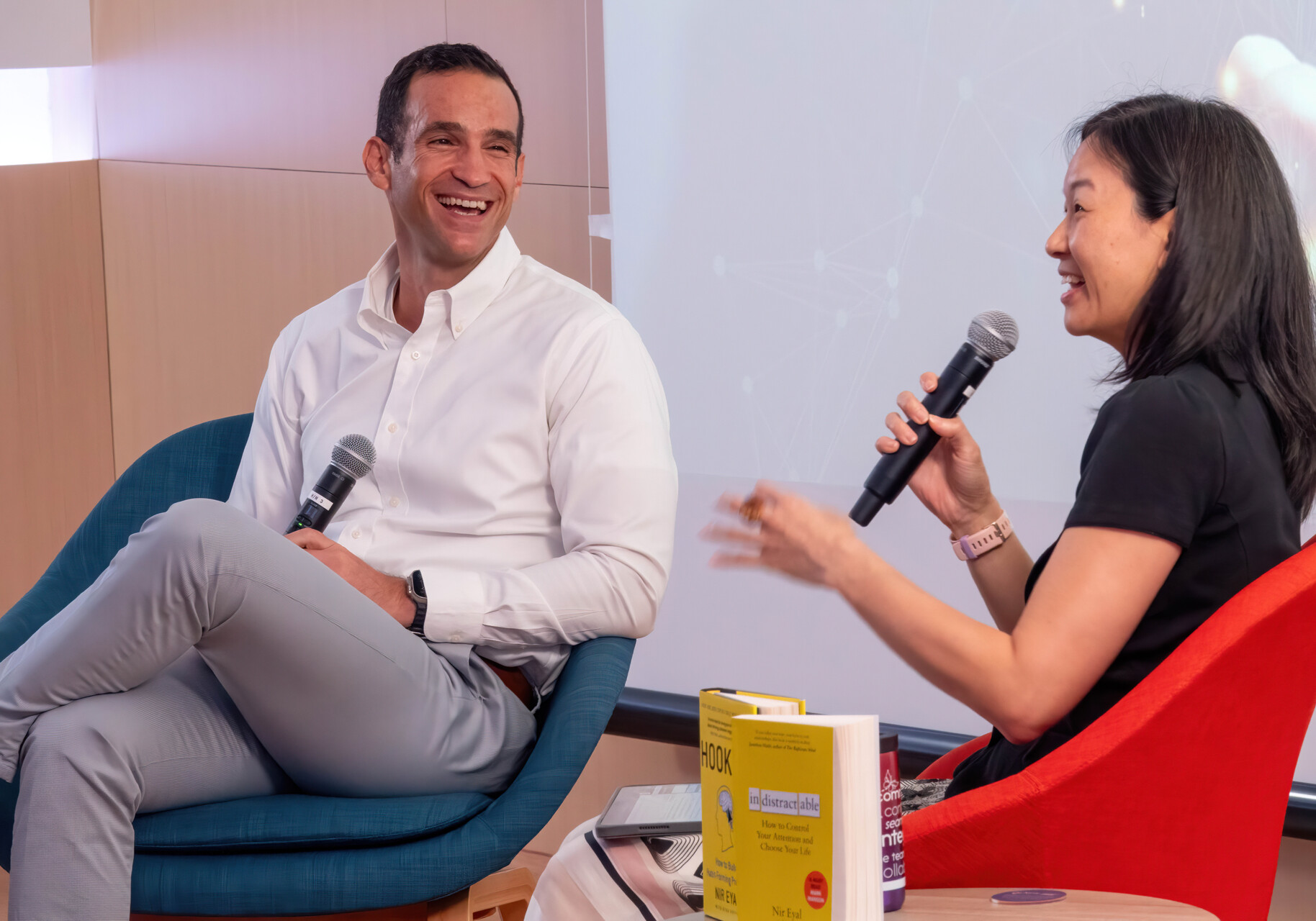What’s the similarity between a durian and an engaging tech product?

Mr Nir Eyal, Author, Speaker and Investor; and Ms Amy Huang, Chief, Digital Products & Platforms Practice, NUS-ISS
“You never know what you’re going to get,” says Mr Nir Eyal at a fireside chat, titled “Driving product engagement for public good”, held at NUS-ISS on 19 May. “Unlike oranges or apples, which never really surprise you, durians have this element of variability that other fruits don’t have."
Mr Eyal is a speaker, investor, and a bestselling author.
Elaborating on his personal experience at durian stores, Mr Eyal says, “Sometimes it’s amazing, sometimes it tastes terrible – it’s like a little slot machine!”
It’s this sense of “mystery” that makes durian more captivating than other fruits. “It makes you either love it or hate it. But for those who are obsessed with the fruit, it could be due to the variability that you get from the durian experience.”
And variability, Mr Eyal emphasises, is a key element of a tech product that gets users hooked.
This is a concept he fleshed out in his book “Hooked: How to Build Habit-Forming Products”. Called the Hook Model, the four-step process is embedded into the products of many successful companies, including social media giants, to subtly encourage customer behaviour. Through consecutive “hook cycles,” these products reach their ultimate goal of bringing users back again and again without depending on costly advertising or aggressive messaging.
Building your habits
What is the Hook model? “Essentially, it’s a design pattern that is intended to connect user problems with products with enough frequency to form a habit,” Mr Eyal says.
The model has four parts: a trigger, an action, a variable reward, and an investment.
There are two types of triggers. External triggers are the things in our environment, like pings and dings, that prompt us to take action. Meanwhile, internal triggers are uncomfortable emotional states like boredom, loneliness, fatigue, uncertainty, and anxiety. “It’s our inability to manage the discomforts of internal triggers that drive us to seek distractions,” Mr Eyal explains.
The next step in the hook model is the action phase. This phase is defined as the simplest behaviour done in anticipation of a reward, such as opening an app, scrolling a feed, or pressing the play button. The action is straightforward, performed in anticipation of an immediate reward.
Then comes the reward itself. However, it’s not enough to simply provide what people expect. Habit-forming products often incorporate some element of mystery, which acts as a variable reward.

Finally and most overlooked, Mr Eyal shares, is the investment phase. This is where the user puts something into the product to make it better with use. The investment phase is crucial in the era of AI, where personalising user experience is becoming increasingly important.
Unlike physical goods that depreciate over time, habit-forming products appreciate in value. “Over time, through repeated cycles of the hook model, users no longer need external triggers – they begin to trigger themselves. This shift from external to internal triggers is the hallmark of a successful habit-forming product,” Mr Eyal says.
How does that work? Imagine the commercial potential of a product that doesn’t rely on expensive advertising or spam messages. Such products are used because they connect to an internal trigger, such as an uncomfortable emotional state. “For instance, if you're uncertain, you Google; if you're bored, you check TikTok; if you're lonely, you open Tinder. These products address specific emotions, leading to habitual use.”
Nobody wants chocolate-covered broccoli
But what if we are trying to encourage people to build habits that are not fun, such as with enterprise software?
“Habits are not necessarily driven by pleasure,” Mr Eyal says. “Most people think motivation is about carrots and sticks – rewards and punishments. However, the reality is that human motivation is fundamentally about escaping discomfort.”
He explains that all human behaviour, even the pursuit of pleasure, is driven by the desire to alleviate some form of discomfort. “Hence, when designing products or services aimed at changing behaviour, it’s important to ask ourselves: What pain can we solve? What is the internal trigger, the frequently occurring emotional itch, that our product can address?”
Consider health apps that used to rely on gamification, offering points, badges, and leaderboards.
A popular approach a few years ago fell out of favour because it often amounted to “chocolate-covered broccoli”, Mr Eyal says. This term describes the attempt to make something people should want (like broccoli) more appealing by covering it with something enticing (like chocolate). “But this just results in an unappealing mess. People don’t want that.”
Instead, Mr Eyal advises, figure out what is the internal trigger. For example, if the internal trigger is boredom, then gamification is great because it’s entertaining. “But in the case of enterprise software, if the internal trigger is workplace stress, the users don’t want your badges and leaderboards – they just want to get their job done.”
At the end of the day, it’s not about “coercing” people into doing something they don’t want to do. “Rather, it’s about focusing on a specific customer, user interaction, and habit that you’re trying to change or port over to a much better interface,” Mr Eyal concludes.
Interested in more seminars or webinars like this? Subscribe to our mailing list here to receive emails on new courses, upcoming seminars and more!
For more information on NUS-ISS Executive Education Programmes in Digital Products & Platforms, visit here.